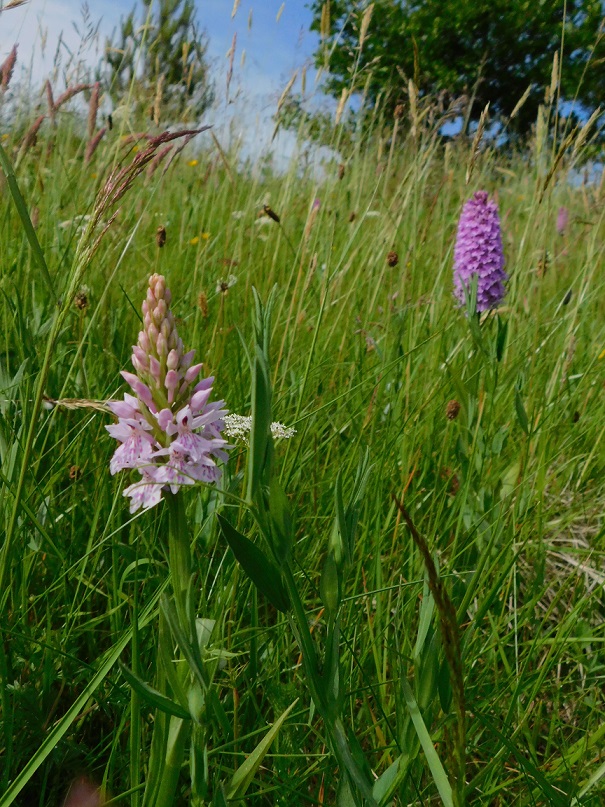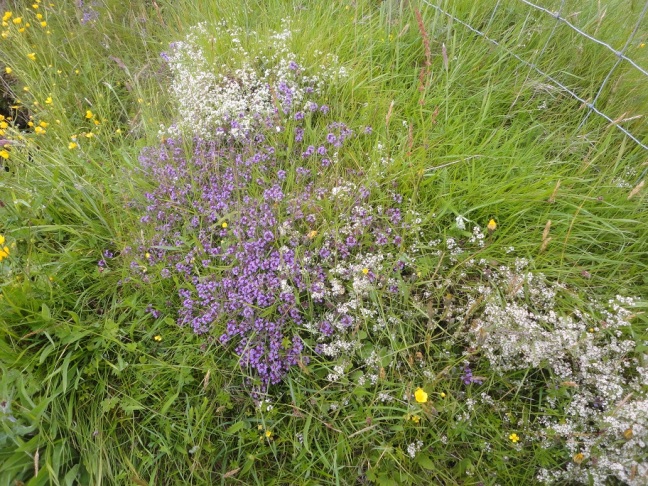I’ve not done much around the holding this week because Douglas, our dog, is recuperating from an operation. This means I am spending much of my time in the house keeping him company, since he mustn’t do any running or jumping at present. Hopefully he will make a good recovery, but at the moment has some healing to do.

I have been taking our other dog, Dyson, out for intensive runs in the tree field to make up. The summer orchids are starting again to show their impressive flowerheads, and I am marking the ones near or on the trackways with sticks, to try and avoid them being trodden on or mown. However, this post I wanted to highlight some of the little, less showy wild flowers that tend to get forgotten about. Individually the flowers may be small, but often they flower prolifically and make the trackways look like a medieval garden lawn. Not all of these photos were taken this week.

The obvious one is the pignut, but that almost qualifies as a large flower, albeit made up of tiny ones, but I have posted about it before. Another that gives most of the field a golden brightness is the buttercup. I have both creeping buttercup (Ranunculus repens), and meadow buttercup (Ranunculus acris), in the tree field.

I may have the third UK buttercup, globe buttercup (Ranunculus bulbosus), since it does grow on Skye, but I have not identified it here yet. When the sun catches the buttercup flowers they are a delight, even if the creeping buttercup is probably my most annoying weed in the areas I am trying to grow things. Mostly because its leaves come away from the roots, which will then regrow. The fact it can spread about 4 feet a year is also a nuisance for a rather laid back gardener like me.

I would include white clover (Trifolium repens), in the small flowers category. The pink clovers quite often have such flamboyant flowers that they stand out alone. White clover tends to be a bit smaller and lower lying, although forms large swathes of blooms on the trackways. It is a food source for the common blue butterfly as well as a nitrogen fixing plant.

Selfheal (Prunella vulgaris) is rather like a tiny purple deadnettle. Sometimes you can see the bright purple of the flowers, and sometimes just the magenta flowerheads. I found one on the mound that had white flowers, but have not seen it since the first year of sheep eviction.

One of my favourite flowers, speedwell (Veronica chamaedrys), is definitely a small flower. I love the colour, an enhancement of the sky above (if not clouded!). Every now and then I come across a good clump of it and it brightens my day. It is a food source for heath fritillary butterflies. Although the flowers are tiny, the colour is so vibrant it is difficult to miss. They also change colour from pink to blue, as they age, which I find fascinating.

When looked at in detail the flowers of eyebright (Euphrasia officinalis agg) are just a beautiful as any orchid. Pale pink snapdragon flowers have a yellow landing strip for insects but are only a few millimeters across. They also only open one or two at a time on the flowerheads. Unfortunately being so small they are easily overlooked, like those of mouse ear (Cerastium fontanum).

One of the things I like about writing up my ‘blogs is that I almost always learn something by researching what I wanted to write about. For example another plant disliked by gardeners is cinquefoil. It was quite a nuisance weed for us on the allotment in Solihull, but didn’t seem to be such a pest for me here. The reason being the Potentilla we have here is tormentil: Potentilla erecta, as opposed to cinquefoil which is Potentilla reptans. Tormentil flowers usually have four petals (rather than five for cinquefoil) and the leaves are usually stalkless unlike cinquefoils leaves. There is quite a bit of this growing in the tree field. It is actually out-competing the grass in some of the areas where the soil is thinner.
Lastly for now I will mention thyme (Thymus polytrichus). A bit like heather it is ubiquitous in the highlands and I am always breaking out into ‘wild mountain thyme’ when the sun shines! Here it grows across the rocks and scree, and I am hoping it will take on my drivebank wall with some encouragement. It makes a great cushion of purple and often is found on the banks of the burn together with heath bedstraw, a tiny cousin of cleavers that forms a cushion of white.


Lovely flowers there. I hope your dog is better soon
LikeLiked by 1 person
Hopefully he will be fine. He thinks he’s under house arrest!
LikeLiked by 1 person
Same here – I hope Douglas will be able to run and jump about soon.
LikeLiked by 1 person
J & D > A paen of praise to the little and overlooked! In our rare rambles out into the wilds of Uist, we are amazed with the variety and number of species under-foot.
LikeLiked by 1 person
The slower you go the more you see.
LikeLike
Everything is looking so beautiful there and is finally lovely here too–I’ve been taking pictures of my flowers every day–the bergamot is incredible this year!
LikeLike
Also, I hope Douglas is feeling better!
LikeLiked by 1 person
Thank you. We’re not sure at the moment unfortunately. It could be more complicated. Back to the vet this week. He’s feeling fine – recovered after his operation, but there may be a general lymphatic system cancer – all his glands are enlarged.
LikeLiked by 1 person
I’m so sorry—crossing my fingers that it’s not.
LikeLiked by 1 person
It’s interesting to see so many of your tiny flowers grow here in Oregon as well…They are many of my favorites. I remember being enchanted by speedwell the first time I saw it – growing in the lawn of our first home in Oregon… Self-heal is one of my favorites here – as a pond edging and flowering “lawn” and just here and there wherever it chooses to be… A couple of the thymes I have planted are beginning to pop up here and there around the garden and path edges – it likes our gritty, dry, low nutrient soil I think. I need to remember that not everything likes rich soil and lots of water… Thanks for this… and blessings on your journey with Douglas… one of those tougher parts of life on planet earth – our “recycling” process…
LikeLiked by 1 person
There were lots more little flowers that got missed out – partly because the flowering timing is wrong, and partly because they are more selective about their location preference. Wild flowers don’t necessarily prefer a less favoured soil, but they thrive without the competition from the grass so much.
Yes the cycle of life is tough. We did hope that Douglas would be with us a few years longer, so we are spoiling him rotten while we can!
LikeLike
I grew an Oregon wildflower this year that I think prefers to grow with a bit of grass – to hold it up! It’s common name is Meadowfoam… So I guess there are some small wildflowers that like growing with grass… Of course there’s grass and then there’s GRASS… You seem to be surrounded by it… There is very little where I live.. just a tiny delicate native that grows for a couple months in the spring along the driveway to the woods… and then is gone… funny how you can miss the things you don’t have. I know what a challenge too much of anything can be, though.
Yes – I spoiled my Ginger the last year of her life, too… I still miss her and haven’t been able to bring myself to replace her, she was so special. Fortunately a couple cats have decided to make their home with me. One even goes on my woodland walks with me each day.
LikeLike
Limnanthes alba? I’ve not come across that here. From what I found online it has an interesting seed oil.
Yes, over the last two hundred years Skye has reverted from subsistance crofting to growing, rather free ranging, sheep! Only the toughest taller plants will withstand their grazing (reeds, thistles and heather). The grass is fine and the little flowers survive in dwarf form. My trees are starting to shade out the grass now, but there will be plenty still in the sunnier spots! Thank you for your comments.
LikeLike
My form of Meadowfoam is the Limnanthes douglasii (named of course after the famous Scottish botanist – like so many things are out here!)… I had not even known about the alba form – which I gather from now reading about it, is grown for it’s oil commercially just a couple hundred miles north of here! How interesting… My more yellow form is useful to bees and hoverflies and smells lovely – but no one talks about it’s oil..
It’s interesting how many parts of the world have been stripped of forests in order to graze sheep and goats and cattle. I gather that when the animals are removed or rotated carefully the land can be quickly reforested or at least re-treed – for perhaps a silvaculture sort of farming – which seems like a lovely balance to me – although lots more natural forest would be good too.
Your part of the world is lovely… I visited Findhorn a few years back and spent some time wandering around northern Scotland. Didn’t make it to Skye unfortunately. Thanks for sharing it with the rest of us… 🙂
LikeLiked by 1 person
I’d not heard Limnanthes Douglasii called meadowfoam, usually it’s called poached egg plant for the flowers. I’ve tried growing it a few times, but it never seems to self seed for me, or gets eaten by slugs I’m not sure. It’s supposed to be a good insect attractant to grow beneath fruit bushes.
Humans are rather keen on doing things quickly. My feeling now is that a more robust approach is to let nature get on with it. See my post https://skyeent.wordpress.com/2017/04/07/lessons-learnt-1-things-gone-wrong/ first two points. A helping hand such as redressing herbivore/carnivore balance becomes very contraversial. Sea eagles are beautiful, but they do take lambs, and kill sheep!
If you make it to Skye do drop in!
LikeLike